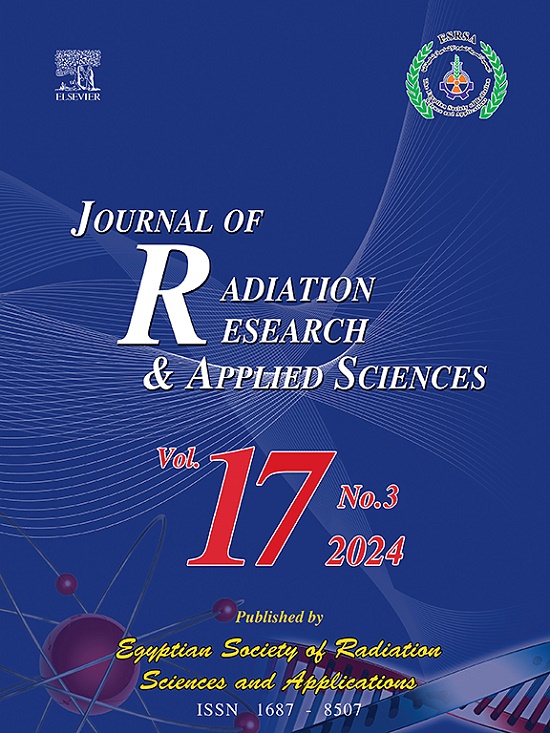Computational assessment of chemically reactive tangent hyperbolic ternary hybrid nanofluid and thermal radiation in a Darcy-Forchheimer regime
IF 1.7
4区 综合性期刊
Q2 MULTIDISCIPLINARY SCIENCES
Journal of Radiation Research and Applied Sciences
Pub Date : 2025-03-22
DOI:10.1016/j.jrras.2025.101397
引用次数: 0
Abstract
This inspection examines the irreversibility analysis of Darcy Forchheimer's flow of tangent hyperbolic tri-hybrid nanofluid through stretching sheets in convective heating conditions. Engine oil (EO) is considered the base fluid for the tri-hybrid nanoparticles containing alumina (), copper (), and titanium oxide (). Thermal radiation, heat source/sink and chemical reaction have been encountered. The entropy generation is expressed as a result of friction in fluids, transfer of heat, and concentration diffusion. The constitution equations have been transmuted by using appropriate transformation. The transmuted equations have been tackled through a BVP4c technique. The influence of various physical variables on the velocity distribution, thermal field, concentration of nanoparticles, entropy generation, Bejan number, drag friction, heat, and mass transfer has been discussed graphically and in tabular form. An enhancement in the inertia coefficient and Weissenberg number shrinkages the profile of the velocity field. However, the thermal field is escalated for the larger magnitude of thermal radiation and Biot number. The entropy minimization and Bejan number augments with the boosting magnitude of the Brinkman number.
Darcy-Forchheimer状态下化学反应切线双曲型三元混合纳米流体和热辐射的计算评估
本研究考察了Darcy Forchheimer的切线双曲型三混合纳米流体在对流加热条件下通过拉伸片的不可逆性分析。发动机油(EO)被认为是含有氧化铝(Al2O3)、铜(Cu)和氧化钛(TiO2)的三杂化纳米颗粒的基础液。遇到了热辐射、热源/热源和化学反应。熵的产生表示为流体摩擦、热量传递和浓度扩散的结果。通过适当的变换,对本构方程进行了变换。通过BVP4c技术解决了变形方程。以图形和表格形式讨论了各种物理变量对速度分布、热场、纳米颗粒浓度、熵生成、贝让数、阻力摩擦、热量和传质的影响。惯性系数和Weissenberg数的增大使速度场的轮廓缩小。然而,随着热辐射强度和Biot数的增加,热场逐渐升级。熵最小化和Bejan数随着Brinkman数的增大而增大。
本文章由计算机程序翻译,如有差异,请以英文原文为准。
求助全文
约1分钟内获得全文
求助全文
来源期刊

Journal of Radiation Research and Applied Sciences
MULTIDISCIPLINARY SCIENCES-
自引率
5.90%
发文量
130
审稿时长
16 weeks
期刊介绍:
Journal of Radiation Research and Applied Sciences provides a high quality medium for the publication of substantial, original and scientific and technological papers on the development and applications of nuclear, radiation and isotopes in biology, medicine, drugs, biochemistry, microbiology, agriculture, entomology, food technology, chemistry, physics, solid states, engineering, environmental and applied sciences.
 求助内容:
求助内容: 应助结果提醒方式:
应助结果提醒方式:


